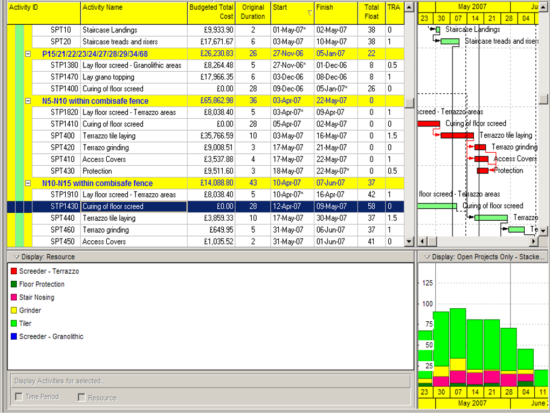
We have recently conducted a detailed survey within the industry to find out people’s experience of managing NEC contracts. The NEC family of contracts have been designed to instil and encourage good practice project management, but the reality is that some of these processes can be misunderstood or mismanaged by individuals or project teams. This bulletin will highlight some of the issues that have been uncovered from this survey with a view of trying to promote better practice and understanding to the industry. We share the questions asked, show the results, and consider ways as an industry that we can improve. Over 150 people were surveyed across a multiple of different projects in different sectors and the results are highlighted below. The survey was undertaken by a cross section of Contractors, Clients, Consultants and Subcontractors to give a real balanced view of the matters highlighted.
Question 1: How many of your projects use an online cloud-based administration tool to manage your NEC documentation flow?
Answer 1: Of those surveyed,72% of projects are using one of the cloud-based systems (e.g. ThinkProject, Oracle Primavera Unifier, Digital Beehive) to manage the flow of communications.

Considerations: This is an encouraging number compared to ten years ago but there is still plenty of room for improvement. A project should benefit from the use of such a system given the relatively low cost in relation to the benefits that they would bring. Such systems encourage correct contractual processes to be followed in a consistent manner and within the prescribed timescales. They provide a full live auditable trail of all the communications at any point in time. These systems efficiently and effectively help manage projects in line with the contract and gives instant auditability and transparency as to where the contract is contractually.
(See also CECA bulletin 12 for more details on cloud-based systems.) The advice would be to get a free trial of these system providers to better understand how they operate and adopt the one that gives you the most benefits from a functional and commercial perspective. We would hope this number exceeds 90% next time we conduct such a survey.
Question 2: Where a cloud-based system is used between Client/Contractor, what proportion of subcontract packages are also managed under a cloud-based system?
Answer 2: Only 33% are adopting a similar use of an equivalent system with their supply chain.
Considerations: There is a concern that many Contractors choose, or are required to use, a system with their Client, but that they do not then cascade the same environment and obligations between the Contractor/Subcontractor. The cloud-based systems encourage the correct processes to be followed, the right language to be used and the correct timescales to be applied. It would show when either party is late with a submission and at any point what action either party has. It encourages the efficient management of early warnings, programme and compensation events throughout the supply chain. It should not come down to cost alone, as these systems are relatively inexpensive and the management time that they will potentially save should mean in the long run they will save all parties money.
Question 3: What percentage of Z clauses would you consider are worthy, useful and contribute to making a positive difference to the management of that project?
Answer 3: On average 29% of Z clauses were considered necessary or beneficial. Interestingly this was the exact same number on a similar but smaller survey conducted in 2014.

Considerations: It is widely accepted as an industry that there are far too many bespoke contractual amendments i.e. too many Z clauses. As an industry, through education, we need to limit the number of amendments that are added to standard contract wording. NEC continues to evolve and listen to industry, and if numerous clients are adding the same Z clauses then there could well be certain elements that the NEC could look to adopt as standard in future contracts. This has been demonstrated in NEC4 where processes such as value engineering, whole life cost savings, requirement for a quality plan, defining “corrupt acts” and introducing “information modelling” were all elements added into standard contract wording. However, the legal advice that clients might get when developing a contract needs to be considered with a note of caution as the NEC was intended to inform all parties about their liabilities and obligations under the contract. The main problem with Z clauses is that they are not as tried and tested as the standard clauses and can end up creating subjectivity or ambiguity, therefore doing more harm than good. They often require additional legal support to support a procurement process or to participate when an issue arises. The whole situation is making it ever harder for the Contractor to manage the perception of risk when engaging with a project. Whilst recognising the commercial driver requiring Contractors to secure work, it is now more important than ever that they and their supply chain challenge some of these amendments and don’tjust sign up without understanding the consequences. The cost of disputes in the industry that may ensue will be much better spent on actually delivering projects that operate with an understandable and balanced risk profile in the first place.
Question 4: How often do you typically get an Accepted Programme?
Answer: Less than 30% of projects are getting a programme accepted every period as the contract intends.

Considerations: The results show that 40% of projects only get a programme accepted every 2-3 months, and a further 30% of projects rarely or ever get an accepted programme. This is a concerning scenario implying that either the quality of Contractor programmes is not good enough to accept, or that Clients are not intent on accepting programmes. The key here must be education. Contractors need to ensure that they submit fully compliant programmes to give the Project Manager no reason to not accept the programme. Project Managers need to understand the benefits of having an accepted programme (see CECA bulletin no 6) and understand the limited liability the Client will be taking on by accepting a programme. An accepted programme is the basis to assess future compensation events, so the lack of a regular revised accepted programme makes this much more difficult and subjective when assessing the impact of change for both Parties.
Question 5: Have you ever experienced a deemed accepted programme where the Project Manager/Service Manager had failed to respond to the programme and a subsequent reminder?
Answer 5: Of those polled, 31% of people surveyed confirmed that this had happened at least once.
Considerations: Very disappointing to see feedback that suggests nearly one third of all Project Managers do not respond to a programme within two weeks, and then even fail to respond to a reminder noting that they have not met their obligations under the Contract. Apparently, they are happy to continue not meeting their obligations for a further week, at which point the programme is accepted anyway! This is especially surprising when we have already seen that 72% of projects are using a cloud-based system that would be highlighting the programme has not been responded to within two weeks of being issued. Education of Project/Service Managers on this point should mean that it should never happen on any project, especially when the Project Manager has the power to delegate any of their powers down to someone who may have more experience and time to ensure that this is applied. Equally importantly, it will help ensure a timely and clear understanding of where the Project is at any point in time to appropriately inform the next steps.
Question 6: What, would you say, is the average response time it takes for the relevant party to respond to a CE quotation?

Answer 6: Only 15% of projects are responding within two weeks as the contract intends. Of course, an extension may be mutually agreed between the parties, but the results show that for nearly 40% of projects, the Project Manager takes several months to respond to a compensation event quotation.
Considerations: It should be in both Parties interest to want to get a compensation agreed as quickly as possible, and the response to the initial quote is the start of that process.
Question 7: What, would you say, is the average time for a CE that is notified to become implemented (agreed)?

Answer 7: nearly 30% of quotes take 3-4 months to get agreement, a further 17% take 4-6 months to be agreed, and 13% take longer than 6 months. Pretty crazy statistics when you consider the whole project was probably tendered within a few weeks, and yet a compensation event being a fraction of the overall tender value often takes months rather than weeks to resolve.
Considerations: As already stated, it should be in both Parties’ interest to get to an agreement in terms of the cost and time impact of a compensation event so that both Parties understand their respective liability. To delay this process and agreement will delay that understanding and potentially allow hindsight to creep in which might muddy the waters of understanding (although contractually hindsight should not affect the assessment made). The two Parties should be holding regular compensation event meetings to review each one that is in the system, to progress it smoothly and efficiently through the lifecycle of notification, quotation, assessment and implementation.
Question 8: What percentage of CE quotations do you find a Project Manager (ECC) or Service Manager (PSC) give a Project Manager/Service Manager assumption on which to base the quotation?
Answer 8: Only 19% find that Project Manager or Service Manager assumptions for compensation events are given. In their absence it means that for 81% of quotations, the Contractor would have to assess the worst-case scenario for risk which is theirs under the contract. This will likely lead to higher quotations that the Project Manager may feel they cannot accept. The Contractor should not include their own assumptions within a compensation event quotation, as there is no where that states that a Contractor assumption can be revisited, or that they would become Project Manager assumptions by default if the quotation was accepted.
Considerations: We have suggested that future editions of NEC contracts allow the Contractor to propose assumptions, and for the Project Manager to accept or not accept those proposed assumptions. That will mean the quotation is more likely to be ringfenced with a more informed balance of risk with the Client only retaining the risk of those assumptions that prove to be incorrect. In the meantime, Contractors can suggest such assumptions for the Project/Service Manager to accept, although these will have to be accepted or confirmed in writing by the Project/Service Manager before the quotation is issued. In the absence of such agreed assumptions, the Contractor will have to continue to assess the worst impact of risk which will potentially to prolong reaching agreement of these events for both Parties.
Question 9: What percentage of compensation event quotations have a specific programme submitted with it?

Answer 9: Of those polled, 36% stated compensation event quotations do have a dedicated programme included.
Considerations: This is not a programme to ever become accepted, but a programme to help the quotation to be understood. The survey result is not terrible, but equally it is likely that a lot more than 36% of compensation events would impact the remaining works on the programme. Under clause 62.2, it is then a requirement to include the alterations to the Accepted Programme within the quotation. Therefore, a lot more compensation quotations should be including a programme to be submitted with it than currently are. Presenting a programme should help understanding, and maybe by many not including one might explain part of the reason why compensation event quotations seem to be taking so long to get agreed.
Question 10: In the past year have you, or anyone in your team, acted on a verbal instruction, or given a verbal instruction expecting it to be followed?
Answer 10: Of those surveyed, 68% confirmed that someone had followed verbal instructions within the past year on their projects.

Considerations: Clause 13.1 states that any communication the contract requires should be in a form that can be read, copied and recorded. Some people sight 10.2 and the requirement to “act in a spirit of mutual trust” as thinking why they should follow such verbal instructions, but that contradicts clause 10.1 (to act as stated in the contract) and clause 13.1. Any instruction to change the Scope should be in writing, and where the Scope states so, communicated through the communication system stated in the Scope (as opposed to by email). This ensures clarity and transparency and no room for any misunderstanding as to who said what and when.
Question 11: Have you ever experienced a deemed accepted for compensation event quotations, where the Project Manager/Service Manager had failed to respond to the quotations and a subsequent reminder?
Answer 11: Of those surveyed 38% people confirmed that they had experienced a deemed accepted quotation.
Considerations: The concern is that for this to happen, the Project Manager would had to have failed to have responded to the quotation within two weeks and for the Contractor to then have notified them in writing of that failure, and then the Project Manager to have ignored the reminder for a further two weeks. Assuming that same project is using a cloud-based system to manage NEC communications, they would be ignoring an outstanding action in that system. The Client would then have no contractual or legal right to challenge the cost and time elements that the Contractor had put forward. The Client is responsible for ensuring that the Project Manager they appoint is acting in their best interests and applying the contractual rules. Failure to follow the contract can sadly and unnecessarily impact adversely on behaviours and project outcomes.
Question 12: What percentage of people in your experience do you find being contractual IS considered bad or negative?

Answer 12: Of those surveyed, 59% of people stated they still come across people who consider contractual is seen as being bad or negative.
Considerations: Clearly another education piece required here. Contractual simply means following the rules of the contract. As long as these are being done constructively there should be no reason for anyone to get upset or think it negative that anyone is choosing to apply the rules of the contract.
Question 13: Do you ever find that having a good relationship leads to relaxing of following the contractual rules?

Answer 13: A very large number, 84% of people confirmed that a good relationship has, in their experience, led to a relaxing of the contractual rules.
Considerations: This could be considered a good thing that the relationships are sufficiently good that people feel they do not need to apply the strict rules. An example might be acting on a verbal instruction knowing it will be followed through in writing at some point in the future.
However, this is not a good approach for so many reasons. If there is a good relationship and understanding between the Parties, then both should understand that following the rules of the contract is both important and necessary. Applying the rules of the contract means that everything is transparent and fully auditable, particularly if there is a change in personnel. All the agreements are captured in one place for everyone to see at any point in time. In the example above, the Contractor should not proceed until the instruction is given in writing rather than thinking a good relationship should ever lead to a bending or relaxing of the rules.
Question 14: Do you find that with CE’s there is still a tendency to wait and see what the actual cost was before agreeing the value of a compensation event?
Answer 14: Of those surveyed 84% said there is a tendency to wait and see what the actual cost was before making the assessment.
Considerations: Clause 63.1 sets the rules as to how a compensation event should be assessed. It states it should be based upon actual Defined Cost of the work done by the dividing date, the forecast Defined Cost of the works done by the dividing date, and the resulting fee. It then confirms that the dividing date for compensation events arising from a Project Manager instruction is the date of that instruction, and for all other compensation events when the compensation event is notified.
This means that for compensation events resulting from instructions that change the Scope should only be based upon forecast Defined Cost as there would not have been any work done before that instruction. It means if the actual work took ten days, but a reasonable forecast to achieve that output was only five days, then the assessment will be based on five days. This encourages Contractors to work optimally and timely on all compensation events and not to think that if the quote is not agreed by the time the work is done, that they will get paid “actual cost” anyway. It also means that Clients can not “sit on the quotation” without agreeing it until the work is done, and then wanting to pay actual cost when the actual cost is less than the quote (and want to pay the quotation value if actual cost is higher than the quotation). This is one of many areas where NEC contracts try to keep a fair level playing field between the Parties.
Question 15: On what percentage of new contracts do you undertake joint contract training between the key parties for a particular project?
Answer 15: Those polled stated that 24% of projects have carried out such a joint workshop on their project, whereas that number was previously much higher ten years ago at 60%
Considerations: Joint workshops particularly considering bespoke amendments are a great collaborative approach to a project where all Parties can be reminded of what the rules are and how they should practically be applied. It appears these are less commonly carried out now than they have been previously. There may be an element of complacency here that people just assume that as NEC has been around for so long that everyone should know and understand the rules. However, this slightly misses the point, and such a workshop should be seen as a chance to encourage and cement the collaborative approach and understanding of the rules that would benefit any project.
Question 16: Roughly what percentage of subcontracts let by the Contractor on your ECC contracts are carried out using the Engineering and Construction Subcontract or the Engineering and Construction SHORT Subcontract (i.e. back to back with an NEC contract)?
Answer 16: Of those polled 58% confirmed that they use an NEC form of contract along the supply chain.
Considerations: This means that still over 40% of projects do not use a back-to-back form of NEC subcontract often choosing a bespoke form of subcontract. This is not ideal as it will mean that the Subcontractor will not have the same liability to follow the NEC processes that the Contractor is obliged to follow, and the Contractor will not have the same sanctions against the Subcontractor if the Subcontractor is not following such rules. Some may consider that the NEC contracts are “too much” for a smaller subcontract for relatively simple or low value works, but that is where the NEC “short” contracts come into their own. If a Contractor is engaged under an ECC contract with the Client, an Engineering and Construction Short Subcontract may be all that is necessary to ensure the key NEC principles are still adhered to but in a simpler and less administrative way.
Summary: The survey results, whilst showing some improvements in certain areas, still show where there is a clear need for greater consistency in the adherence to the contract across the parties. Better education and awareness aligned to the application of the contractual rules will help achieve the benefit that the NEC contracts were intended to deliver. Both preparing and addressing submissions in a timely manner and in accordance with the contract will increase the efficiency of the process during project delivery. Whilst encouraging the reduction in the use of Z will help remove the contractual ambiguity that might otherwise arise and will better inform all parties as to their likely liabilities under the contract and how they can appropriately manage this.
There are obviously some simple quick wins that can be applied to benefit any project, but some elements that will need a longer-term effort to see improvements.
Whilst our industry must be adaptable and prepared to change to overcome some of the challenges noted in this summary bulletin, there is a need to produce clear and concise contract documents that appropriately manage those obligations placed on the parties in a manner that they can appropriately consider the inherent risk. This aspect will need further cross industry engagement to ensure that our industry can deliver future infrastructure in a fair and efficient manner. However, ever there are a few considerations bulleted below that might help address some of the feedback from the survey:
- Consider the use of cloud-based systems to administer your projects all the way along the supply chain
- challenge ineffectual or unfair contract amendments
- avoid the use of bespoke contracts where feasible
- ensure a regular accepted programme
- agree compensation events in a timely manner
- encourage Project Manager assumptions for CE quotations
- do not act on verbal instructions
- respond within contractual timescales
- consider being contractual a positive not a negative thing
- run multi-party training for a bespoke project so everyone hears the same rules
- developing good relationships whilst encouraged shouldnot be at the expense of following the contract

